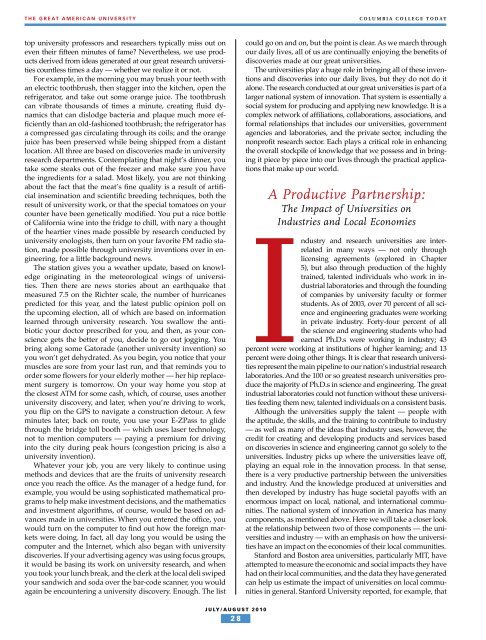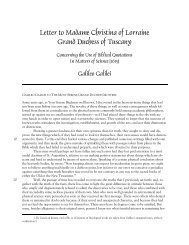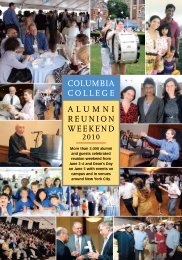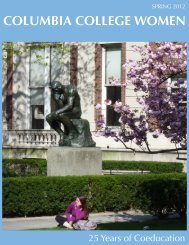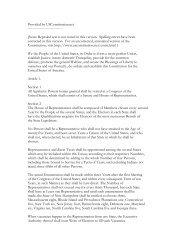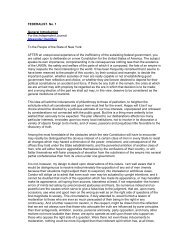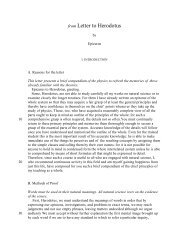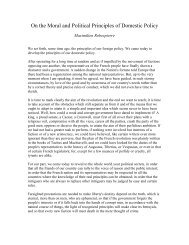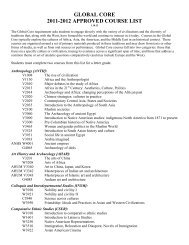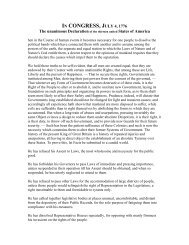Congratulations, Class of 2010! - Columbia College - Columbia ...
Congratulations, Class of 2010! - Columbia College - Columbia ...
Congratulations, Class of 2010! - Columbia College - Columbia ...
You also want an ePaper? Increase the reach of your titles
YUMPU automatically turns print PDFs into web optimized ePapers that Google loves.
the great american university<br />
columbia college today<br />
top university pr<strong>of</strong>essors and researchers typically miss out on<br />
even their fifteen minutes <strong>of</strong> fame Nevertheless, we use products<br />
derived from ideas generated at our great research universities<br />
countless times a day — whether we realize it or not.<br />
For example, in the morning you may brush your teeth with<br />
an electric toothbrush, then stagger into the kitchen, open the<br />
refrigerator, and take out some orange juice. The toothbrush<br />
can vibrate thousands <strong>of</strong> times a minute, creating fluid dynamics<br />
that can dislodge bacteria and plaque much more efficiently<br />
than an old-fashioned toothbrush; the refrigerator has<br />
a compressed gas circulating through its coils; and the orange<br />
juice has been preserved while being shipped from a distant<br />
location. All three are based on discoveries made in university<br />
research departments. Contemplating that night’s dinner, you<br />
take some steaks out <strong>of</strong> the freezer and make sure you have<br />
the ingredients for a salad. Most likely, you are not thinking<br />
about the fact that the meat’s fine quality is a result <strong>of</strong> artificial<br />
insemination and scientific breeding techniques, both the<br />
result <strong>of</strong> university work, or that the special tomatoes on your<br />
counter have been genetically modified. You put a nice bottle<br />
<strong>of</strong> California wine into the fridge to chill, with nary a thought<br />
<strong>of</strong> the heartier vines made possible by research conducted by<br />
university enologists, then turn on your favorite FM radio station,<br />
made possible through university inventions over in engineering,<br />
for a little background news.<br />
The station gives you a weather update, based on knowledge<br />
originating in the meteorological wings <strong>of</strong> universities.<br />
Then there are news stories about an earthquake that<br />
measured 7.5 on the Richter scale, the number <strong>of</strong> hurricanes<br />
predicted for this year, and the latest public opinion poll on<br />
the upcoming election, all <strong>of</strong> which are based on information<br />
learned through university research. You swallow the antibiotic<br />
your doctor prescribed for you, and then, as your conscience<br />
gets the better <strong>of</strong> you, decide to go out jogging. You<br />
bring along some Gatorade (another university invention) so<br />
you won’t get dehydrated. As you begin, you notice that your<br />
muscles are sore from your last run, and that reminds you to<br />
order some flowers for your elderly mother — her hip replacement<br />
surgery is tomorrow. On your way home you stop at<br />
the closest ATM for some cash, which, <strong>of</strong> course, uses another<br />
university discovery, and later, when you’re driving to work,<br />
you flip on the GPS to navigate a construction detour. A few<br />
minutes later, back on route, you use your E-ZPass to glide<br />
through the bridge toll booth — which uses laser technology,<br />
not to mention computers — paying a premium for driving<br />
into the city during peak hours (congestion pricing is also a<br />
university invention).<br />
Whatever your job, you are very likely to continue using<br />
methods and devices that are the fruits <strong>of</strong> university research<br />
once you reach the <strong>of</strong>fice. As the manager <strong>of</strong> a hedge fund, for<br />
example, you would be using sophisticated mathematical programs<br />
to help make investment decisions, and the mathematics<br />
and investment algorithms, <strong>of</strong> course, would be based on advances<br />
made in universities. When you entered the <strong>of</strong>fice, you<br />
would turn on the computer to find out how the foreign markets<br />
were doing. In fact, all day long you would be using the<br />
computer and the Internet, which also began with university<br />
discoveries. If your advertising agency was using focus groups,<br />
it would be basing its work on university research, and when<br />
you took your lunch break, and the clerk at the local deli swiped<br />
your sandwich and soda over the bar-code scanner, you would<br />
again be encountering a university discovery. Enough. The list<br />
could go on and on, but the point is clear. As we march through<br />
our daily lives, all <strong>of</strong> us are continually enjoying the benefits <strong>of</strong><br />
discoveries made at our great universities.<br />
The universities play a huge role in bringing all <strong>of</strong> these inventions<br />
and discoveries into our daily lives, but they do not do it<br />
alone. The research conducted at our great universities is part <strong>of</strong> a<br />
larger national system <strong>of</strong> innovation. That system is essentially a<br />
social system for producing and applying new knowledge. It is a<br />
complex network <strong>of</strong> affiliations, collaborations, associations, and<br />
formal relationships that includes our universities, government<br />
agencies and laboratories, and the private sector, including the<br />
nonpr<strong>of</strong>it research sector. Each plays a critical role in enhancing<br />
the overall stockpile <strong>of</strong> knowledge that we possess and in bringing<br />
it piece by piece into our lives through the practical applications<br />
that make up our world.<br />
A Productive Partnership:<br />
The Impact <strong>of</strong> Universities on<br />
Industries and Local Economies<br />
Industry and research universities are interrelated<br />
in many ways — not only through<br />
licensing agreements (explored in Chapter<br />
5), but also through production <strong>of</strong> the highly<br />
trained, talented individuals who work in industrial<br />
laboratories and through the founding<br />
<strong>of</strong> companies by university faculty or former<br />
students. As <strong>of</strong> 2003, over 70 percent <strong>of</strong> all science<br />
and engineering graduates were working<br />
in private industry. Forty-four percent <strong>of</strong> all<br />
the science and engineering students who had<br />
earned Ph.D.s were working in industry; 43<br />
percent were working at institutions <strong>of</strong> higher learning; and 13<br />
percent were doing other things. It is clear that research universities<br />
represent the main pipeline to our nation’s industrial research<br />
laboratories. And the 100 or so greatest research universities produce<br />
the majority <strong>of</strong> Ph.D.s in science and engineering. The great<br />
industrial laboratories could not function without these universities<br />
feeding them new, talented individuals on a consistent basis.<br />
Although the universities supply the talent — people with<br />
the aptitude, the skills, and the training to contribute to industry<br />
— as well as many <strong>of</strong> the ideas that industry uses, however, the<br />
credit for creating and developing products and services based<br />
on discoveries in science and engineering cannot go solely to the<br />
universities. Industry picks up where the universities leave <strong>of</strong>f,<br />
playing an equal role in the innovation process. In that sense,<br />
there is a very productive partnership between the universities<br />
and industry. And the knowledge produced at universities and<br />
then developed by industry has huge societal pay<strong>of</strong>fs with an<br />
enormous impact on local, national, and international communities.<br />
The national system <strong>of</strong> innovation in America has many<br />
components, as mentioned above. Here we will take a closer look<br />
at the relationship between two <strong>of</strong> those components — the universities<br />
and industry — with an emphasis on how the universities<br />
have an impact on the economies <strong>of</strong> their local communities.<br />
Stanford and Boston area universities, particularly MIT, have<br />
attempted to measure the economic and social impacts they have<br />
had on their local communities, and the data they have generated<br />
can help us estimate the impact <strong>of</strong> universities on local communities<br />
in general. Stanford University reported, for example, that<br />
july/august <strong>2010</strong><br />
28


